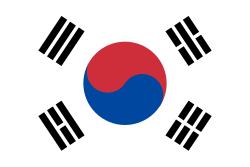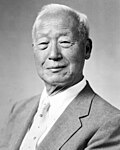Portal:South Korea
 |
대한민국 포털
The South Korea Portal


South Korea, officially the Republic of Korea (ROK), is a country in East Asia. It constitutes the southern half of the Korean Peninsula and borders North Korea along the Korean Demilitarized Zone, with the Yellow Sea to the west and the Sea of Japan to the east. Like North Korea, South Korea claims to be the sole legitimate government of the entire peninsula and adjacent islands. It has a population of about 52 million, of which half live in the Seoul Metropolitan Area, the ninth most populous metropolitan area in the world; other major cities include Busan, Daegu, and Incheon.
The Korean Peninsula was inhabited as early as the Lower Paleolithic period. Its first kingdom was noted in Chinese records in the early seventh century BC. From the mid first century BC, various polities consolidated into the rival kingdoms of Goguryeo, Baekje, and Silla. The lattermost eventually unified most of the peninsula for the first time in the late seventh century AD, while Balhae succeeded Goguryeo in the north. The Goryeo dynasty (918–1392) achieved lasting unification and established the basis for the modern Korean identity. The subsequent Joseon dynasty (1392–1897) generated cultural, economic, and scientific achievements and also established isolationism starting from the mid-17th century. The succeeding Korean Empire (1897–1910) sought modernization and reform but was annexed in 1910 into the Empire of Japan. Japanese rule ended following Japan's surrender in World War II, after which Korea was divided into two zones: the Soviet-occupied northern zone and the United States-occupied southern zone. After negotiations on reunification failed, the southern zone became the Republic of Korea in August 1948, while the northern zone became the communist Democratic People's Republic of Korea the following month.
In 1950, a North Korean invasion triggered the Korean War, one of the first major proxy conflicts of the Cold War, which saw extensive fighting involving the American-led United Nations Command and the Soviet-backed People's Volunteer Army from China. The war ended in 1953 with an armistice and left three million Koreans dead and the economy in ruins; due to the lack of a peace treaty, the Korean conflict is still ongoing. South Korea endured a series of dictatorships punctuated by coups, revolutions, and violent uprisings, but also experienced a soaring economy and one of the fastest rises in average GDP per capita, leading to its emergence as one of the Four Asian Tigers. The June Democratic Struggle of 1987 ended authoritarian rule and led to the establishment of the current Sixth Republic. (Full article...)
Selected article -
Japan–South Korea relations (Japanese: 日韓関係, romanized: Nikkan kankei; Korean: 한일관계; RR: Hanil gwangye) are the diplomatic relations between Japan and the Republic of Korea. As the Sea of Japan and the Korea Strait geographically separate the two nations, political interactions date back from the 6th century when the kingdom of Baekje (which encompassed much of present-day South Korea) officially established relations with the Yamato Kingship of Japan. During the ancient era, the southern region of the Korean Peninsula served as the closest port for economic trade and cultural exchange between the Japanese archipelago and mainland Asia. Such relations would continue by the late 19th century when both Japan and Korea underwent modernisation from Western powers up until 1910, when Korea became a colony of Japan.
Shortly after gaining independence from the Japanese surrender at the end of World War II in 1945, Korea was divided into two states. During the Korean War, Japan took part in aiding South Korea by providing military supplies to US and UN forces against the communist-led North Korea.
Japan and South Korea formally established diplomatic relations in December 1965, under the Treaty on Basic Relations Between Japan and the Republic of Korea, with Japan recognising South Korea as the only legitimate government in the Korean Peninsula. (Full article...)
Selected image

South Korea is located in East Asia, on the southern half of the Korean Peninsula jutting out from the far east of the Asian land mass. The only country with a land border to South Korea is North Korea, lying to the north with 238 kilometres (148 mi) of border running along the Korean Demilitarized Zone. South Korea is mostly surrounded by water and has 2,413 kilometres (1,499 mi) of coast line along three seas; to the west is the Yellow Sea, to the south is the East China Sea, and to the east is the East Sea. Geographically, South Korea's land mass is approximately 100,032 square kilometres (38,623 sq mi). 290 square kilometres (110 sq mi) of South Korea are occupied by water. The approximate coordinates are 37° North, 127° 30 East. Notable islands include Jeju Island (Jejudo), Ulleung Island (Ulleungdo), and Liancourt Rocks (Dokdo).
More did you know -
- ...that the fish Coreoleuciscus splendidus had a movie named after in 1999?
- ...that South Korean screenwriter and director Byeon Seung-wook spent five years working on the scenario for his 2006 directorial debut film, Solace?
- ...that the South Korean film The Host was recognized as Best Picture at the 1st Asian Film Awards, held in 2007?
In the news
- 15 August 2025 – Gwangbokjeol, 2025 South Korean presidential election
- South Korean president Lee Jae Myung holds a "de facto" inauguration ceremony, known as the "People's Mandate Ceremony", coinciding with the 80th anniversary of Korea's liberation from Japan at Gwanghwamun Square in Seoul, where he receives letters of appointment from 80 selected individuals. Lee took office on June 4 after winning the 21st presidential election without an official inauguration ceremony. (Anadolu Ajansı)
- 14 August 2025 – North Korea–South Korea relations
- Kim Yo Jong, sister of North Korean supreme leader Kim Jong Un, states in a KCNA article that the rumour that North Korea had removed the loudspeakers in the Korean Demilitarized Zone is false. (Al Jazeera) (The Independent)
- 12 August 2025 –
- The Seoul Central District Court issues an arrest warrant for former South Korean first lady and Yoon Suk Yeol's spouse Kim Keon Hee on three charges related to stock manipulation, allegations of accepting luxury gifts, and illegal political funding during the 2022 by-election. It is the first time in the country's history that a former presidential couple has been taken into custody. (The Guardian)
- 8 August 2025 – 2024 South Korean martial law crisis
- The Seoul Central District Court rejects a petition brought by former interior minister Lee Sang-min regarding the arrest warrant against him over his alleged involvement in former president Yoon Suk Yeol's martial law attempt on December 3, 2024. (The Korea Times)
- 6 August 2025 –
- Former South Korean first lady Kim Keon Hee appears for questioning by a special prosecutor in central Seoul. The investigation concerns allegations of stock manipulation, bribery, and interference in People Power Party nominations. (AP)
- 2 August 2025 –
- Four-term National Assembly lawmaker Jung Chung-rae is elected as the leader of the Democratic Party in South Korea during the national party convention at KINTEX in Goyang, Gyeonggi Province, defeating his rival Park Chan-dae with 61.74% of the votes. (Yonhap News Agency)
The Third Battle of Seoul was a battle of the Korean War, which took place from December 31, 1950, to January 7, 1951, around the South Korean capital of Seoul. It is also known as the Chinese New Year's Offensive, the January–Fourth Retreat (Korean: 1·4 후퇴) or the Third Phase Campaign Western Sector (Chinese: 第三次战役西线; pinyin: Dì Sān Cì Zhàn Yì Xī Xiàn).
In the aftermath of the major Chinese People's Volunteer Army (PVA) victory at the Battle of the Ch'ongch'on River, the United Nations Command (UN) started to contemplate the possibility of evacuation from the Korean Peninsula. Chinese Communist Party chairman Mao Zedong ordered the Chinese People's Volunteer Army to cross the 38th Parallel in an effort to pressure the UN forces to withdraw from South Korea.
On December 31, 1950, the Chinese 13th Army attacked the Republic of Korea Army (ROK)'s 1st, 2nd, 5th and 6th Infantry Divisions along the 38th Parallel, breaching UN defenses at the Imjin River, Hantan River, Gapyeong and Chuncheon in the process. To prevent the PVA forces from overwhelming the defenders, the US Eighth Army now under the command of Lieutenant General Matthew B. Ridgway evacuated Seoul on January 3, 1951. (Full article...)
General images -
Did you know (auto-generated)

- ... that a lost stone monument for a park in Seoul that closed in 1919 was discovered lying in the grass in 2002?
- ... that Nam Su-hyeon, Jeon Hun-young, and Lim Si-hyeon's gold medal in the women's team archery event at the 2024 Olympics marked South Korea's tenth victory in a row?
- ... that a senior colonel with 30 years' experience in North Korean intelligence agencies defected to South Korea in 2014?
- ... that Cho Myung-chul was the first North Korean defector to be elected to the South Korean National Assembly?
- ... that G Affairs was presented at project markets in South Korea, Taiwan, and Hong Kong, but rejected because it was deemed unmarketable in China?
- ... that South Korea has a day to celebrate North Koreans?
WikiProjects
See WikiProject Korea for collaborating on South Korea topics, and more broadly, on all things Korea-related.
Categories
Related portals
East Asia
Associated Wikimedia
The following Wikimedia Foundation sister projects provide more on this subject:
-
Commons
Free media repository -
Wikibooks
Free textbooks and manuals -
Wikidata
Free knowledge base -
Wikinews
Free-content news -
Wikiquote
Collection of quotations -
Wikisource
Free-content library -
Wikiversity
Free learning tools -
Wikivoyage
Free travel guide -
Wiktionary
Dictionary and thesaurus
Web resources
- The official website of the Republic of Korea (Korea.net)
- The Official Korea Tourism Guide Site
- Korea National Statistical Office
- Video on South Korea-US Relations from the Dean Peter Krogh Foreign Affairs Digital Archives
- "South Korea". The World Factbook (2025 ed.). Central Intelligence Agency.
- A Country Study: South Korea in the Library of Congress
- South Korea from UCB Libraries GovPubs
- Korea OECD
- South Korea profile from the BBC News
- South Korea Encyclopædia Britannica entry
- The War Memorial of Korea
- Key Development Forecasts for South Korea from International Futures
Sources














































